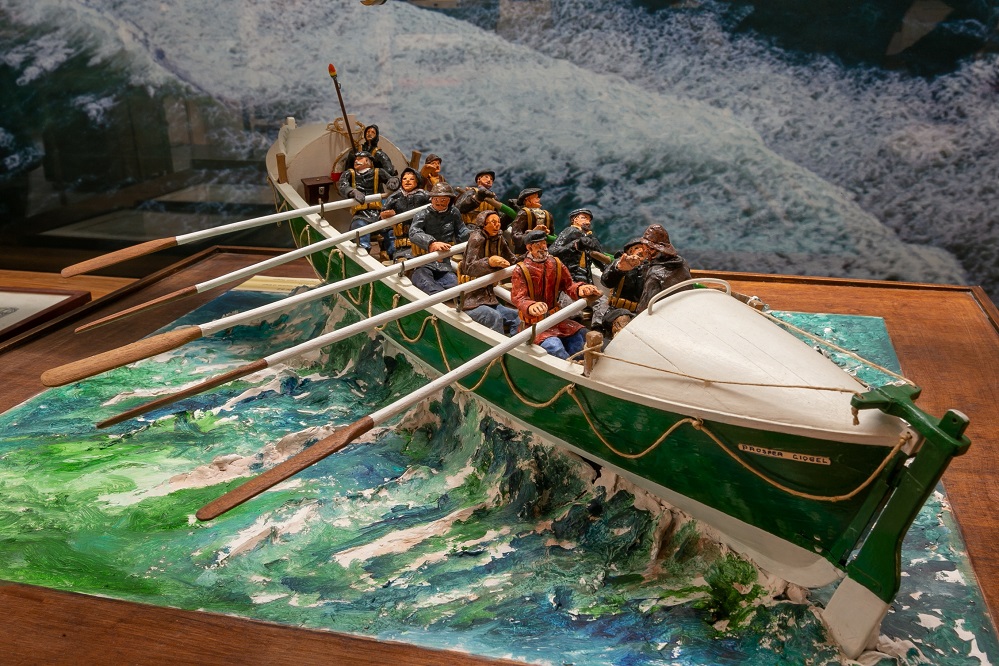
Sea Rescue
Etel sailors are confronted with the permanent danger posed by the entrance to the ria, which is partially blocked by a sandbank. A veritable underwater dune shaped by marine currents, this bank generates a double risk: Its fluctuating position and shallow draught expose ships to being struck or grounded. In bad weather or contrary currents, the large swell from the open sea breaks on contact with it. Crossing it then becomes particularly dangerous, if not impossible. This rare and spectacular natural phenomenon has given its name to the Barre d'Etel.
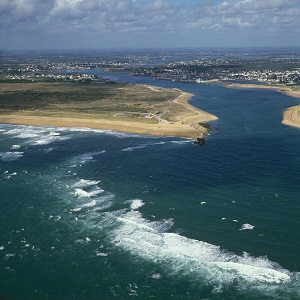
The permanent difficulties and the accidents on the bar very quickly encouraged the very young commune of Etel (1850) to equip its port with a lifeguard station. In 1865, the Empress Eugénie, wife of Napoleon III, agreed to the request and supported the project. The creation of the station was published in the Journal Officiel on 18 November of the same year. The text emphasised that "the life and future of an entire commune are at stake". After Groix, Etel is the second resort in Morbihan to be created.

From 1866, at the southern end of the port, along the quays bordering the Pradic beaching cove, opposite the bar, the Ponts et Chaussées built, at their own expense, a shelter house equipped with a slipway for launching. The station was affiliated to the Société Centrale de Sauvetage des Naufragés, created in February 1865. The first boat, La Seyne, was delivered at the beginning of January 1867. Built by the Société des Forges et Chantiers de la Méditerranée based in La Seyne, this 9.78m wooden vessel was powered by 10 oars. Mounted on a trolley, the boat was pulled out of the slipway by force of arms. Very quickly in bad condition, it was disarmed in June 1888 and sold in 1889.
The Prosper Giquel, replaces La Seyne in January 1889. Built in Le Havre in 1882 by the Chantiers Augustin Normand, she was initially assigned to the Oran station. 10.10m long, also propelled by 10 oars, the Prosper Giquel benefits from a righting system in case of capsize. In 1894, to facilitate its launching, the hold of the shelter was extended by 25 m, to the edge of the channel. The Prosper Giquel remained in service in Etel until 1913, when it was sold.

Her successor, the Papa Poydenot, was the third and last rowing boat of the station. Sistership of the Prosper Giquel (same characteristics, same shipyard), the Papa Poydenot arrived in Etel in 1913, after 13 years of service at the Saint-Pierre-Penmarc'h station. This boat was at the height of the port in the 1930s with its 230 tuna dories. It was in service until 1939. Its name was taken over by the rowing boat of the same type, preserved in Penmarch, the ex-Benoît Champy, classified as a historical monument in 1992 and still sailing today.
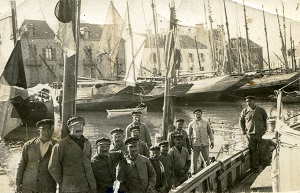
From January 1867 to June 1939, the rowing boats carried out 110 rescue missions and rescued a large number of shipwrecked people.
In 1938, the port was expanded. A new quay and a quay wall were built in the southern part of the harbour. The SCSN then decided to allocate a motorised lifeboat to the station. A new shelter and its launching chute were also built in the western extension of the previous one. Built by the Limousin company (Paris), the building is made of reinforced concrete on posts. It has a ramp with wooden runners.
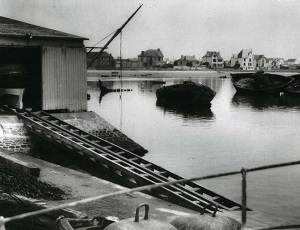
The Vice-Amiral Schwerer, built in the Jouët shipyards in Sartrouville, was delivered new in May 1939 and christened on 1 July. She opened the era of wooden motorboats at the station. Known as the "All Weather", the V-A Schwerer is equipped with two 35hp diesel engines capable of propelling it at a speed of 7 knots. In 1958, after 29 rescue trips, the ship left for Fécamp to the Normandy shipyard to be modernised and assigned to the Saint-Jean-de-Luz station.
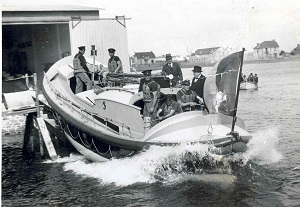
To replace her, the Pourquoi-Pas, from Saint-Servan (Saint-Malo), which had just been refitted, arrived in Etel on 19 May 1958, taking on the name of Vice-Amiral Schwerer. Two months later, she assisted the last sailing tuna vessel in the port, the Prosper, grounded on the bar (sorties 140 and 141 on 18 July).
The next intervention was dramatic: On 3 October 1958, Alain Bombard tested his inflatable life raft on the Etel bar. The raft capsized in the rollers. The lifeboat intervened but in turn overturned. 4 "volunteer castaways" accompanying Bombard and 5 rescue sailors lost their lives. Among them was Emile Daniel, skipper of the V-A Schwerer lifeboat, whose last outing it was.
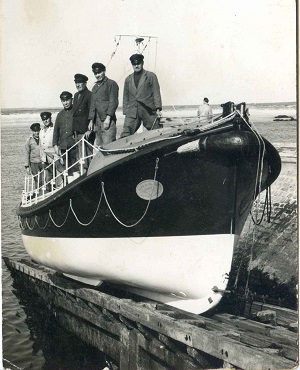
This tragedy marked a double turning point in the history of rescue and safety at sea. From that date onwards, despite the accident, the Bombard liferaft, whose reliability was proven, was imposed - and became the norm - on all ships. The system was adopted throughout the world. The tragedy also revealed a design flaw in the lifeboats fitted to the stations. Although the lifeboat was unsinkable, contrary to what had been claimed, it was not self-righting.
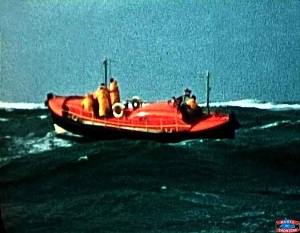
Following the tragedy, their design was rethought. Unsinkability and self-righting will now be combined. Four years later, the station was equipped with a new generation boat.
During this time, the bar was the scene of another tragedy, a direct consequence of the previous one: the grounding of the trawler La Souriante, at the end of January 1960. Due to the lack of a lifeboat in Etel, the civil protection authorities sent a helicopter. While attempting to heliport the crew, the helicopter hit a mast of the ship and crashed into the sea. The pilot and the mechanic perished.
In 1962, to accommodate this 6th boat, a new shelter house was built opposite the municipal ice house. It overhangs the new quay which serves as its base. Oriented North-South (unlike the first shelters, which were oriented East-West), the shelter opens its western façade onto the river. It is equipped with a metal gate that can be tilted by counterweights. The canoe is launched laterally thanks to an atypical system of descent by electric davits (same model as those of the liner France). The machinery, designed by the workshops J. Paris (Nantes), consists of 2 davits mounted on slides. The davits support the boat by means of steel cables. The launching time varies between 5 and 7 minutes depending on the water level.
It is one of only three of its kind installed in France. Those of Dunkerque and Oléron are no longer in operation. The Etel shelter is therefore the last remaining example in France, and one that is in perfect working order.
An important witness to both local and national maritime heritage, the complex is now maintained by the commune, the Sagemor and the Association Patron Emile Daniel (A.PE.D.), made up of former Etellois lifeguards and sailors.
The building and its launching mechanism (cad. F 417), by decree of 08 August 2008, are now registered on the list of buildings protected as Historic Monuments in the Morbihan department.
On 3 June 1962, Etel received the Patron Emile Daniel, in homage to the skipper of the previous boat lost in the 1958 accident. It was blessed very soberly on the following 2 September. Fishing activity declined but the danger of the bar and the development of pleasure boating still justified the need for her presence. Occasionally, the skipper Emile Daniel assisted in the launching of trawlers from the shipyards in the ria and then towed them to the port. Finally, like its predecessors, the boat takes part every year in the blessing of the sea, taking on board the clergy and the celebrants.
In 1985, the dinghy underwent a complete overhaul at the Audierne shipyard: major refit, replacement of the engines and installation of a wheelhouse. The boat was severely damaged during a night intervention on 8 September 2003 (gutted over 8 m and one engine destroyed) and was forced into retirement. The SNSM preferred to replace it. The emblematic boat was decommissioned in September 2003, after 41 years of service (183 trips), which is a national record for longevity! She was restored by the local shipyard Rameau, assisted by students from the technical and maritime high schools of Etel and the Association Patron Emile Daniel (APED).
The canoe Patron Emile Daniel celebrated its 50th anniversary on 02 June 2012. Unlike its shelter, the boat is not yet listed. Nevertheless, in Etel, the "Emile Daniel" is naturally a historical monument.